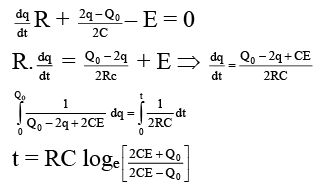Integer Answer Type Questions for JEE: Electromagnetic Induction & Alternating Current | Chapter-wise Tests for JEE Main & Advanced PDF Download
Q.1. Find the mutual inductance if number of turns in primary and secondary coils is increased to two times each.
Ans. 4
∴ M becomes 4 times.
Q.2. In an ac circuit, V and I are given by V = 150 sin (150t) V and
Find the power dissipated in the circuit.
Ans. 5625
Compare V =150 sin (150t) with V = V0 sin ωt , we get V0 = 150 V
Compare I
we get
I =150 A, ϕ = π/3 = 60º
The power dissipated in ac circuit is
Q.3. A 100 W resistor is connected to a 220 V, 50 Hz ac supply. What is the rms value of current in the circuit?
Ans. 2.8
Here, R = 100 Ω, Vrms = 220 V, v = 50 Hz
Q.4. A conductor is moving with the velocity v in the magnetic field and induced current is I. If the velocity of conductor becomes double, the induced current will be _________
Ans. 2I
When the velocity of conductor becomes double, area intercepted becomes twice. Therefore induced current becomes twice.
Q.5. A series LCR circuit containing a resistance of 120 Ώ has angular resonance frequency 4 × 105 rad/sec. At resonance the voltage across resistance and inductance are 60 V and 40 V respectively. At what frequency (in 105) the current in the circuit lags the voltage by 45º?
Ans. 8
At resonance reactance X = 0
As VL = iXL = iωL
or
L = 0.2 mH
At resonance
In LCR circuit,
Q.6. A series LCR circuit with R = 20 Ώ, L = 1.5 H and C = 35 μF is connected to a variable-frequency 200 V ac supply. When the frequency of the supply equals the natural frequency of the circuit, what is the average power in Kw transferred to the circuit in one complete cycle?
Ans. 2
When frequency of supply is equal to natural frequency,
Q.7. The magnetic field at all points within the cylindrical region whose cross – section is indicated in the accompanying figure starts increasing at a constant rate b. The induced electric field, E, satisfies E ∝ rp (r < R) and E ∝ r–q (r > R)
E ∝ rp (r < R) and E ∝ r–q (r > R)
Where, r is the distance from the axis of the region. Find the value of p + q.
Ans. 2
Here, we shall discuss three situations i.e. when r lies inside, at the surface and outside the region CASE I: For ≤ R (inside):Using,
⇒ E (2πr) = (πr2)β
∴ E ∝ r,
So, E –r graph is a straight line passing through origin.
CASE II: At r = R (at the surface)
E (2πR) = (πR2)β
∴ E = Rβ/2
CASE III: For r ≥ R (outside)
⇒ E (2πr) = (πR2) (β)
⇒ E = αR2/wr
∴
Q.8. A non–conducting ring of radius R having uniformly distributed charge Q starts rotating about x–x' axis passing through diameter with an angular acceleration α as shown in the figure. Another small conducting ring having radius a (a << R) is kept fixed at the centre of bigger ring is such a way that axis xx¢ is passing through its centre and perpendicular to its plane. If the resistance of small ring is r = 1Ω, find the induced current in it in ampere.
(Given  R = 1 m, a = 0.1 m, α = 8 rad/s2)
R = 1 m, a = 0.1 m, α = 8 rad/s2)
Ans. 8
Q.9. A uniform disc of radius r and mass m is charged uniformly with the charge q. This disc is placed flat on rough horizontal surface having coefficient of friction μ. A uniform magnetic field is present in a cylindrical region (a > r) but varying as kt3 as shown in figure. Find the time in second after which the disc beings to rotate. (Given r = 1 m, m = 18 kg, q = 1 C, μ = 0.1 , K = 4, g = 10 m/s2) 
Ans. 2
Maximum torque due to friction force
dτ = μdmgx
Q.10. The figure shows a RC circuit with a parallel plate capacitor, before switching on the circuit plate A of the capacitor has a charge – Q0, while plate B has no net charge. Now at t = 0, the circuit is switched on. How much time (in second) will elapse before the net charge on plate A becomes zero. (Given C = 1 µF, Q0 = 1 mC, E = 1000 V and  ).
).
Ans. 2
At any time t charge q flow from plate B to plate A Kirchoff's law
Putting the value of C, Q0, E and R we get t = 2sec.
|
446 docs|929 tests
|















































